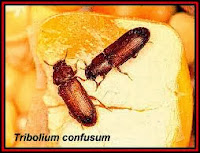 I know what you are thinking. You are thinking, "I can't read this blogpost because I LOVE sushi and she WILL NOT ruin it for me!" Don't worry, I'm a big fan of sushi too, and I certainly don't want to diminish the amazingness that is this Japanese delicacy. Let me start off by saying that most of the time, especially here in the U.S. or in countries with well-regulated sushi bars (such as is the case in Japan), you are not at risk for contracting parasites from eating sushi. I'll end this post with a brief discussion about raw fish regulations just to ease your troubled mind. That being said, let's talk about the parasites that you can get from eating raw fish that hasn't been properly processed.
I know what you are thinking. You are thinking, "I can't read this blogpost because I LOVE sushi and she WILL NOT ruin it for me!" Don't worry, I'm a big fan of sushi too, and I certainly don't want to diminish the amazingness that is this Japanese delicacy. Let me start off by saying that most of the time, especially here in the U.S. or in countries with well-regulated sushi bars (such as is the case in Japan), you are not at risk for contracting parasites from eating sushi. I'll end this post with a brief discussion about raw fish regulations just to ease your troubled mind. That being said, let's talk about the parasites that you can get from eating raw fish that hasn't been properly processed.There are many different species of parasites that use fish as one of their hosts. Any of these parasites has the potential to infect humans if accidentally eaten. You can pick up a variety of flukes, tapeworms, and roundworms from a variety of marine and freshwater fish. To keep this blogpost to a reasonable size, we will only look at one representative from each of these three groups. We will talk about the fluke Clonorchis sinensis, the tapeworm Diphyllobothrium latum, and the roundworm Anisakis simplex.
Because we are looking at three different worms under the theme of "can be in sushi", I won't go into the detail that I normally do. I've never blogged about C. sinensis or about A. simplex, but you can find a previous blogpost about D. latum here. (Perhaps I'll blog about the other two in later posts.)
 |
| Clonorchis specimens from a patient. |
 |
| Anisakis worms embedded in a herring. |
 | |
| Ceviche |
Now that I have you thoroughly terrified, let's talk about how much effort we go through to prevent ourselves from being infected. In the U.S. (and probably many other places), we have regulations pertaining to the serving of raw fish. Raw fish, no matter where it comes from, must be processed to make sure that parasites are killed. This is done by freezing and/or treating with salt and/or chlorine. The FDA states that freezing temperatures and times vary with the nature of the fish to be frozen and the parasites to be killed. It seems that they recommend between -4 degrees F or less for 7 days and -31 degrees F or less for 15 hours for most cuts of fish. Thicker cuts need to be kept colder longer. The FDA goes on to say that brining and pickling are not safe ways to control for fish parasites as they are not effective methods for reducing parasite threats. Recent studies have shown that while not optimally effective alone, treatment of fish with chlorine in conjunction with ultrasound processing significantly reduces parasites in fish meat. Using an ultrasound for at least 30 minutes is another method for controlling for fish parasites that seems to work pretty well. The only other method that this author knows about is treating the meat with at least 15% NaCl (salt) after 7 days of storage. The paper I read about that bit pointed out that 20% NaCl was better and could be used after only 6 days of storage. I'm sure there are other methods, but these seem to be the most prominent as far as I can tell.
The risk of actually contracting these parasites in the United States is low. The liver fluke (C. sinensis) is extremely rare in the U.S. with most reported cases demonstrating patients who contracted the parasite in another country before coming to the US. Infections with D. latum are also rare in the U.S. despite once being common in people living around the Great Lakes. Recent cases have popped up from the West Coast, but are still not very prevalent. There are less than 10 cases of anisakiasis reported each year in the U.S.
The other bit of good news is that if you happen to contract any of these by some off chance of bad luck, they are almost never fatal. Additionally, they are rather easy to treat with drugs readily available here in the states.
The Moral of the Story
Don't ever let anyone make you feel bad for eating sushi...unless you are in a country with poor food regulations and the food looks sketchy, then you should definitely not eat the sushi. Use good judgement and know the warning signs just in case. You should be able to get plenty of good sushi, sashimi, gefilte fish, and ceviche here in the US of A since we make it a point to be especially careful when handling raw fish. Go celebrate with a dragon roll or some ebi!!!
 |
| Mmmmm!!! |


















